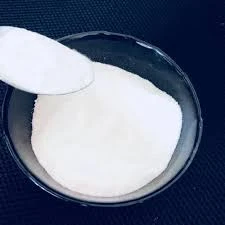
Dec . 16, 2024 03:05 Back to list
hpmc cellulose
Understanding HPMC Cellulose A Multifaceted Polymer in Modern Applications
Hydroxypropyl Methylcellulose (HPMC) is an important cellulose derivative that has gained significant attention in a variety of industries due to its versatile properties. As a non-ionic polymer, HPMC is derived from cellulose, a natural polymer originally sourced from plant cell walls. The modifications made to the cellulose structure through hydroxypropyl and methyl etherification not only enhance its solubility and stability but also impart unique functionalities that make it suitable for numerous applications.
One of the most remarkable properties of HPMC is its ability to dissolve in cold water, creating a clear, viscous solution. This contrasts with most cellulose derivatives, which typically require heat to dissolve. As a result, HPMC is frequently utilized in pharmaceutical formulations—specifically as a thickening agent and binder in tablet production. Its excellent adhesive properties help to maintain the structural integrity of tablets, ensuring consistent release profiles of active ingredients over time. This regulatory feature is essential in the development of controlled-release medications, providing patients with sustained therapeutic effects.
Understanding HPMC Cellulose A Multifaceted Polymer in Modern Applications
Construction materials also benefit from the properties of HPMC. In cement and mortar applications, HPMC acts as a water-retaining agent, which is critical in ensuring that the mixture remains workable for longer periods during application. Additionally, its use helps prevent crack formation in the curing process of concrete, thereby improving the durability and stability of structures. The construction industry often relies on HPMC for its ability to enhance the consistency and adhesion of the mixtures, making it a staple additive in modern building materials.
hpmc cellulose

In the realm of cosmetics and personal care products, HPMC serves multiple roles, including as a thickener, emulsifier, and stabilizer. Its non-toxic and biodegradable nature makes it an ideal ingredient for lotions, creams, and gels. Consumers are increasingly looking for products that contain natural and safe ingredients, and HPMC meets this demand while providing improved viscosity and texture in formulations.
The versatility of HPMC extends beyond these applications to sectors such as textiles and agriculture. In textile processing, HPMC can act as a sizing agent or coating that helps improve the finish of fabrics. Its film-forming ability leads to enhanced durability and wear resistance of textile products. In agriculture, HPMC is employed in coatings for seeds, which helps to improve germination rates by providing a controlled release of nutrients and protecting seeds from environmental stressors.
However, it should be noted that the production and use of HPMC come with an environmental responsibility. As industries seek to move towards more sustainable practices, there is an increasing focus on the sourcing of cellulose and the overall lifecycle of HPMC products. Manufacturers and researchers are continuously exploring eco-friendly alternatives and biotechnological advances to ensure that HPMC can be produced with minimal environmental impact.
In conclusion, Hydroxypropyl Methylcellulose stands out as a highly versatile polymer that spans multiple industries from pharmaceuticals and food to construction and cosmetics. Its unique properties make it an invaluable ingredient that enhances the functionality and quality of numerous products. As research progresses and sustainable practices take center stage, HPMC is poised to remain a pivotal component in the development of innovative solutions that meet the evolving needs of consumers and industries alike.
-
Versatile Hpmc Uses in Different Industries
NewsJun.19,2025
-
Redispersible Powder's Role in Enhancing Durability of Construction Products
NewsJun.19,2025
-
Hydroxyethyl Cellulose Applications Driving Green Industrial Processes
NewsJun.19,2025
-
Exploring Different Redispersible Polymer Powder
NewsJun.19,2025
-
Choosing the Right Mortar Bonding Agent
NewsJun.19,2025
-
Applications and Significance of China Hpmc in Modern Industries
NewsJun.19,2025







